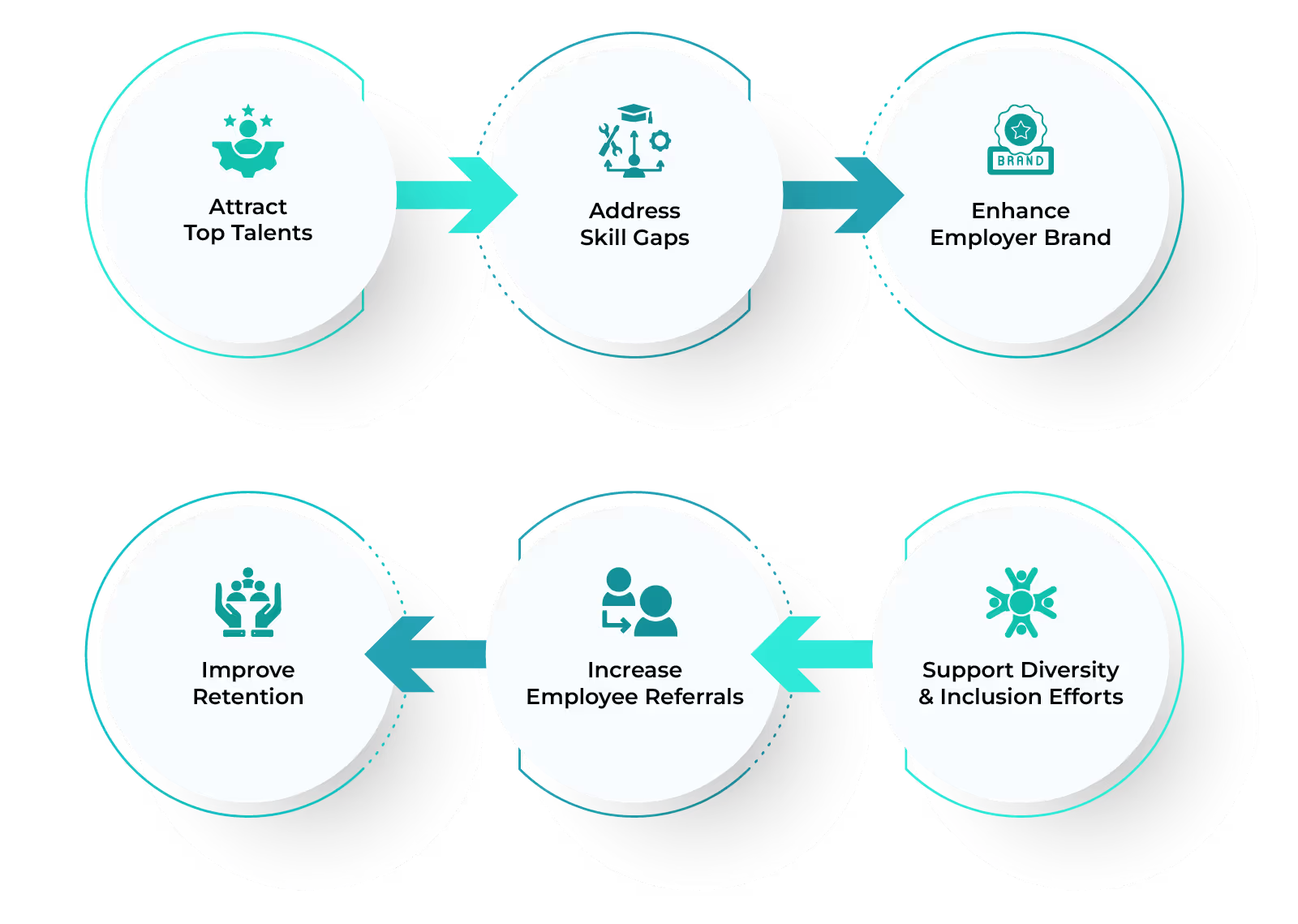
Blog
Recruitment Incentive: Benefits, Types and Differences from Traditional Hiring Methods
May 24, 2024


Key Insights
Only an HR can relate to the long months spent searching for your ideal candidate.
You posted a job vacancy. But for months it has been hard to find a skilled professional who is suitable for the position.
The clock is ticking and it's time you close the vacancy.
In such a stagnant situation recruitment incentives can help you widen your pool of finding the right person for the job.
In this blog, we will deal with recruitment incentives, their types, and benefits. We will also discuss steps to determine appropriate recruitment rewards. Make a comparison with traditional hiring approaches.
All this information will help you build a recruitment incentive plan that enhances your hiring process.
Scroll down for more.
What are Recruitment Incentives?
Organizations use special incentives to attract potential candidates to their organization. These incentives called recruitment incentives are used when the company finds it hard to fill a job vacancy.
Recruitment incentive plan goes beyond the usual salary package and other employee benefits. This can include relocation assistance, flexible work arrangements, performance bonuses, etc.
In a competitive job market, recruitment incentives help attract skilled professionals to fill key pistons in an organization.
Types of Recruitment Incentives
A high-paying job simply cannot attract skilled professionals to your organization. You need to offer a variety of recruitment incentives that align with your employee preferences and business capacity.
So here are a few recruitment incentives for employees to attract top talents:

Signing Bonuses
Organizations offer a lump-sum amount to new hires upon joining or completing the probation period. This bonus intends to attract candidates with in-demand skills to the organization.
Relocation Assistance
At times new hires might need to relocate to be a part of your team. In such instances, organizations provide moving expenses, temporary housing, and other assistance for a smooth transition.
Stock Options
Organizations offer company stocks at a discounted price or as a part of the compensation package. New joiners feel a sense of ownership and align their goals with the company’s success.
Flexible Work Arrangements
Many consider having flexible work hours, remote work options, or compressed work weeks as an incentive. This helps them maintain a work-life balance and increases their productivity.
Comprehensive Benefits
Organizations offer health insurance, paid time off, and parental and wellness leave. Many candidates find these benefits appealing as they enhance their overall compensation package.
All these recruitment incentives are structured to attract skilled candidates to your organization.
It focuses on providing a smooth transition to a new job environment without affecting their productivity.
Benefits of Offering Recruitment Incentives
The work spaces are changing fast and organizations need to take extra steps to stand out.
With recruitment incentives, you can achieve the goal of setting yourself apart.
So what are the benefits of putting effort into building recruitment incentives? Let's check:

Attract Top Talents
The job market is competitive and finding the right candidate becomes hard. Including special incentives in your recruitment package helps attract skilled professionals who suit your organizational culture.
Address Skill Gaps
Offering incentives for targeted positions that require skill and expertise helps fill skill gaps. This helps find the most suitable candidate who can contribute to the job requirements.
Enhance Employer Brand
Providing recruitment incentives can enhance your employer's brand in the job market. This contributes to a positive brand image and work culture that appeals to suitable candidates.
Support Diversity and Inclusion Efforts
Recruitment incentive plans can be tailored to accommodate diverse needs and preferences. This helps in hiring diverse candidates thereby supporting diversity and inclusion efforts.

Increase Employee Referrals
Referral bonuses can be made part of your recruitment incentives. This encourages employees to tap their network to identify potential candidates for the job vacancy.
Improve Retention
Recruitment incentives aim to provide a healthy workspace for employees. This enhances their engagement, satisfaction, and loyalty and reduces turnover.
Recruitment incentive plays a crucial role in enhancing your overall hiring process. From finding top talents to ensuring their satisfaction and retention, its benefits are long.
How to Determine Appropriate Recruitment Incentives
Knowing all these benefits there is no turning back from not choosing recruitment incentives.
Now there are a variety of incentives out there. Choosing the one that suits your needs and operations is crucial for its effectiveness.
According to the 2024 Candidate Experience Report, most candidates pay close attention to how a company carries out its hiring process.
This calls for paving a systematic path that determines your recruitment incentives.
Let's look at what this structured process is that enhances your entire hiring process:

Define Recruitment Objectives
Outline your objectives. For which job role are you hiring? What are the skill requirements for the particular job? What is the ideal candidate profile for the vacancy?
Finding answers to these questions will help you in deciding your recruitment objectives.
Evaluate Industry Standards
Companies must study what the rest of the people are doing with their incentive plans. What are the industry standards? What are the competitors offering?
Finding answers to these questions will help ensure the competitiveness of your incentive program.
Assess Organizational Resources
Companies must be aware of their budget allocation and resource availability. What can you offer a new hire in a particular post? To what extent can it be maintained?
Finding answers to these questions will help in making judicious use of resources for optimal results.
Solicit Employee Input
Always seek feedback and opinions from your employees. How effective is the current recruitment incentive? What is the scope of improvement?
Finding answers to these questions will help build and maintain an incentive that caters to the needs and preferences of the employee.
Customize Incentives
Companies must be flexible with their incentives and rewards. Ask employees what their needs and preferences are. What makes them feel happy and satisfied?
Finding answers to these questions will help in providing incentives that motivate your employees and boost their productivity.
Monitor and Measure Effectiveness
Companies must have a routine check on the effectiveness of their recruitment incentives. What are the strengths? What are the bottlenecks?
Finding answers to these questions helps in making regular adjustments that ensure its relevance and effectiveness.
Your appropriate recruitment incentive changes with time and people. So there needs to be a system where you follow these steps at regular intervals.
This ensures that the incentive tool delivers the desired results and outcomes.
Differences from Traditional Hiring Methods
The traditional method of recruitment takes a standard and structured approach.
The HR puts out a job posting and conducts screenings and interviews to finally find the right candidate. Here the candidates are offered salary and benefits based on industry standards.
All candidates who have applied get similar offers without any customization. The focus lies in filling the post with the qualified candidate.
While the recruitment incentive way of hiring takes a more personalized approach in its process.
The primary focus is still on finding the most suitable candidate for the job vacancy. But it does not limit itself to just hiring.
Recruitment incentive plans hire the right person for the job by offering what appeals to them the most. It tries to understand the needs and preferences of the candidate to customize the pay and benefits accordingly.
Through these efforts, recruitment incentives find skilled professionals while ensuring their satisfaction and retention.
In addition, it taps the networks of its existing employees to scout the perfect fit while reducing hiring costs.
In short, the traditional method of hiring is focused on one task- finding the right one.
While the recruitment incentives for employees take a comprehensive approach to ensuring a long-term impact on employee well-being and organizational growth.
Final Thoughts
Companies get a competitive edge in the hiring market when candidates leave positive reviews.
In fact, 60% of candidates leave positive reviews online when they have a positive experience during the hiring process.
It means everything about your recruitment process is out there and readily available. These reviews have a serious impact on your employer branding.
This also calls for companies to ensure a comprehensive hiring experience. You need to promptly communicate the acceptance and rejection. You need to provide respectable pay that follows industry standards.
However, we know by now that employer branding doesn't end with respectable pay!
The current potential candidate expects much more from the company. These incentives and rewards are offered during recruitment, not just hiring the skilled professional for the position. But will determine their behavior, motivation, performance, and productivity in the coming period.
Now is the time for Companies and HR executives to explore the possibilities of offering recruitment incentives to your workforce.
To read more about incentive-related topics, visit https://www.kennect.io/. If you are looking to automate your incentive program, then Book A Demo NOW.
ReKennect : Stay ahead of the curve!
Subscribe to our bi-weekly newsletter packed with latest trends and insights on incentives.
Thank you! Your submission has been received!
Oops! Something went wrong while submitting the form.
Your data is in safe hands. Check out our Privacy policy for more info














